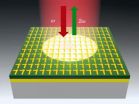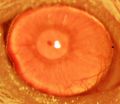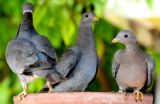(Press-News.org) A team including researchers from the U.S. Geological Survey (USGS) and the San Diego Zoo's Institute for Conservation Research has developed a novel methodology that for the first time combines 3D and advanced range estimator technologies to provide highly detailed data on the range and movements of terrestrial, aquatic, and avian wildlife species.
A paper detailing the project, called 'Movement-based Estimation and Visualization of Space Use in 3D for Wildlife Ecology and Conservation', was published July 2 in the PLOS ONE online science journal. A video of the project can be viewed on SeedMe at https://www.seedme.org/condor_vis.
Relying on expertise from researchers at the San Diego Supercomputer Center (SDSC) at the University of California, San Diego, the team created highly detailed data sets and visualizations after they tracked three highly iconic but threatened species: California condors, giant pandas, and dugongs – a large marine animal somewhat similar to the manatee. (See sidebar on tracking the panda and dugong.)
From Days to Minutes
"We were able to speed up their software by several orders of magnitude," said Robert Sinkovits, SDSC's Director of the Scientific Applications Group, which helps researchers make optimal use of SDSC's larger supercomputers, including Gordon and Trestles. "In this case, calculations that had formerly taken four days to complete were finished in less than half an hour."
What started as a supercomputing challenge – since 3D modeling is much more computationally data intensive than 2D – actually became an exercise in optimizing codes that makes it possible for the current problems of interest to be done on laptops or even smart phones.
"While the researchers with the San Diego Zoo and USGS came to SDSC for our supercomputing, they stayed for our expertise," said Sinkovits. "We welcome them to use both our systems and expertise to solve other challenges that were previously considered to be intractable."
Gordon is being used to create interactive visualizations, and will make it easier for the software developers to explore the impact of algorithmic modifications on the quality of the solution.
The visualization expertise was provided by Amit Chourasia, senior visualization scientist at SDSC.
"We made changes to write the data into a more compact format, which enabled swift output and ingestion," said Chourasia. "A key goal was to allow the experts to visualize the data directly on Gordon via remote access, as it is essential to minimize data movement and replication especially when data sizes grow. Currently, we're working to fuse data from various sources such as topography and climate to further aid the understanding of such habitats."
2D or Not 2D
"Our collaborative research team has created a novel and powerful tool for visualizing and modeling animal home ranges in 3D that harnesses the power of SDSC to fully exploit the increasing size and quality of 3D animal biotelemetry tracking and datasets," said James Sheppard, a senior researcher within the Applied Animal Ecology Division of the San Diego Zoo's Institute for Conservation Research, and a member of the research team. "This provides us with deeper insights into patterns of animal space-use and informs strategies for the conservation management of endangered species and their habitats."
Specifically, the project's advancement centered on the use of 3D technology for home range estimators, as opposed to traditional 2D systems typically used by ecologists. In a graphic image, the x and y axes denote width and height, while the z axis denotes depth, or vertical movement. The team developed what is called a movement-based kernel density estimator (MKDE) to estimate animal movements.
"We show that analyses and visualization using 3D MKDEs are more accurate and informative than traditional 2D estimators in representing the space use of animals that have a substantive vertical component, such as those that fly, traverse steep terrain, or dive in the water," said Jeff Tracy, an ecologist at the USGS and lead author of the study.
"Biologists and ecologists are only beginning to recognize the value of incorporating the vertical aspect into analyses, which more realistically represents the space used by an animal," added Tracy, who developed the key algorithm vital to this research.
California Condors
One aspect of the study focused on learning more about the range and movements of the California condor. While its population now stands at approximately 400 birds – up from only 22 in the mid- 1980s – conservation efforts to reintroduce this ecologically-important species to its former habitat in the mountains of California and Mexico have been hampered by a lack of understanding about condor movement patterns and habitat use. To address this, the San Diego researchers have been attaching miniaturized GPS biotelemetry units to every condor that it releases into the wild, to gather valuable tracking data.
"We have been calculating home ranges for the tracked condors in three dimensions for the first time using this GPS location data, and our novel density estimator was used to incorporate the vertical component of animal movements into projections of space-use," said Sheppard.
Although the team successfully developed appropriate algorithms for creating 3D home ranges, actually extending animal home range volumes into 3D is computationally demanding, especially for animals tracked using highly accurate GPS telemetry devices for which high-resolution home ranges should be calculated to capitalize on the fine-scale location data collected.
"It is also highly computationally intensive to generate 3D home ranges from GPS telemetry data collected from animals that occupy habitats encompassing large areas, such as the California condors and giant pandas tracked in the wild by San Diego Zoo Global and its collaborators. These computing challenges are why researchers have typically only analyzed animal ranges in 2D up until now," said Sheppard.
Using this 3D technology, researchers can link the resulting home range data to customized climate models of condor habitats, also in 3D, to generate high-resolution images of condor spatial behaviors, habitat use, and the climatic conditions that stimulate and modify condor movements.
"This data will be used as a predictive management tool to inform conservation efforts to restore condor populations, particularly with regard to emerging threats such as climate change and wind energy impacts," added Sheppard.
Big Data and Ecology
On a broader note, Sheppard noted that the field of ecology is entering the era of 'Big Data' so it is imperative that new analytical and visualization tools be developed that can process, manage, and analyze these increasingly large and accurate multidimensional datasets acquired from biotelemetry tracking devices and remote sensing technologies. "Otherwise ecologists and conservation managers may literally not be able to see the forest for the trees," he said.
INFORMATION:
Additional information on the project is at http://www.werc.usgs.gov/animalspace3d and a blogpost can be read here.
In addition to Tracy and Sheppard, researchers for the study included Jun Zhu (University of Wisconsin, Madison); Fuwen Wei (Chinese Academy of Science, Beijing); Ronald Swaisgood (San Diego Institute for Conservation Research); and Robert Fisher (USGS, San Diego).
The California Condor tracking part of the study was funded or supported by San Diego Zoological Global, the United States Fish and Wildlife Service, Sempra Energy, and Mexico-based organizations including Instituto Nacional de Ecologia, Comision Nacional Para El Conocimiento y Uso de la Biodiversidad, Secretaria de Medio Ambiente y Recursos Naturales, Wildcoast/Costasalvaje. The Giant Panda research was funded by the National Natural Science Foundation of China, Wildlife Experimental Platform of Chinese Academy of Sciences, and San Diego Zoo Global. Funding and support for the dugong research was provided by CRC Reef, Australian Research Council LIEF Scheme, and James Cook University.
SDSC assists researchers in novel wildlife tracking project
Researchers combine 3-D technologies to track land, aquatic and avian species
2014-07-02
ELSE PRESS RELEASES FROM THIS DATE:
Noninvasive advanced image analysis could lead to better patient care
2014-07-02
PHOENIX, Ariz. — July 2, 2014 — Lung cancer patients could receive more precise treatment, and their progress could be better tracked, using a new high-tech method of non-invasive medical imaging analysis, according to a study published today by the journal PLOS ONE.
Genetic changes increasingly are recognized as driving cancer development. But obtaining evidence of these changes usually requires a biopsy, which can be problematic for sensitive regions of the body such as the lungs.
Based on a review of 48 patients with non-small cell lung cancer (NSCLC), the study ...
Researchers invent 'meta mirror' to help advance nonlinear optical systems
2014-07-02
Researchers at the Cockrell School of Engineering at The University of Texas at Austin have created a new nonlinear metasurface, or meta mirror, that could one day enable the miniaturization of laser systems.
The invention, called a "nonlinear mirror" by the researchers, could help advance nonlinear laser systems that are used for chemical sensing, explosives detection, biomedical research and potentially many other applications. The researchers' study will be published in the July 3 issue of Nature.
The metamaterials were created with nonlinear optical response ...
A million times better
2014-07-02
This news release is available in German.
Lasers have a fixed place in many fields of application. Yet, there are still wavelengths for which either no systems exist, or at best only large and expensive ones. On the other hand remote sensing and medical applications call for compact laser systems, for example with wavelengths from the near infrared to the Terahertz region.
A team of researchers at the Technische Universitaet Muenchen (Germany) and the University of Texas Austin (USA) has now developed a 400 nanometer thick nonlinear mirror that reflects frequency-doubled ...
Scientists can now screen for stem cells that enhance corneal regrowth
2014-07-02
A Boston-based scientific collaborative, led by Harvard Stem Cell Institute (HSCI) researchers, has discovered a way to collect the best cell type for regenerating a damaged cornea—the clear membrane that covers the pupil and directs light into the back of the eye. The investigators report in the journal Nature that purified human stem cells can be used to improve long-term vision in mice. The team is now pursuing FDA-approval for the technique before moving on to patient clinical trials.
The study, lead by co-senior investigators Natasha Frank, MD, and Markus Frank, ...
Die-offs of band-tailed pigeons connected to newly discovered parasite
2014-07-02
A new pathogen has been discovered by scientists investigating major
die-offs of pigeons native to North America, according to studies led
by the University of California, Davis, and the California Department
of Fish and Wildlife.
Scientists were able to implicate this new parasite, along with the
ancient parasite Trichomonas gallinae, in the recent deaths of
thousands of Pacific Coast band-tailed pigeons. The die-offs occurred
during multiple epidemics in California's Central Coast and Sierra
Nevada mountain ranges. Scientists named the new pathogen Trichomonas
stableri.
Avian ...
Computer-automated, time-lapse embryo photography may increase success of IVF
2014-07-02
PHILADELPHIA - Using computer-automated, time‐lapse photography of embryos in the laboratory during in-vitro fertilization may improve embryo selection, potentially increasing the chances of pregnancy among women undergoing the procedure, according to new research from the Perelman School of Medicine at the University of Pennsylvania and five other fertility centers. Results of the study were presented this week at the 30th annual European Society of Human Reproduction and Embryology (ESHRE) meeting in Munich, Germany.
The researchers at Penn and their collaborators ...
Novel intravaginal ring shows promise for HIV prevention
2014-07-02
A novel intravaginal ring implanted with anti-retroviral drug tablets, or pods, demonstrated sustained and controlled drug release and safety over 28 days, according to a paper published ahead of print in Antimicrobial Agents and Chemotherapy. The ring, designed to prevent transmission of HIV, was tested in pig-tailed macaque monkeys, and is engineered to be inexpensive, all the better for use in developing countries, says corresponding author Marc Baum.
One of the two drug combinations tested in the ring had been shown in three clinical trials to prevent HIV—some of ...
Veterans with muscle injuries and mental health conditions more likely to end service
2014-07-02
ANN ARBOR, Mich. — Sixty percent of U.S. Army soldiers who were unable to return to a military career after an Iraq deployment couldn't do so because of a muscle, bone or joint injury and nearly half had a mental health diagnosis, according to a new study from the University of Michigan and VA Ann Arbor Healthcare System.
Lower rank, which indicated socioeconomic status, was also a predictor of poor health outcomes among service members, according to the research that appears in the Journal of Bone and Joint Surgery and was led by a former Army Major who served in ...
Japanese gold leaf artists worked on a nanoscale
2014-07-02
Ancient Japanese gold leaf artists were truly masters of their craft. An analysis of six ancient Namban paper screens show that these artifacts are gilded with gold leaf that was hand-beaten to the nanometer scale. Study leader Sofia Pessanha of the Atomic Physics Center of the University of Lisbon in Portugal believes that the X-ray fluorescence technique her team used in the analysis could also be used to date other artworks without causing any damage to them. The results are published in Springer's journal Applied Physics A: Materials Science & Processing.
Gold leaf ...
A tale of a tail -- Kangaroos' powerful 'fifth leg'
2014-07-02
A Simon Fraser University study on how kangaroos use their tails as a 'fifth' leg is providing new insight into the diversity of biological movement, and specific insight into why we walk the way we do.
Published today in the Royal Society journal Biology Letters, the study, led by professor Max Donelan of SFU's Locomotion Laboratory, found kangaroos, commonly viewed as hoppers, move with a "pentapedal" gait, planting their tails on the ground in combination with their front and hind legs.
"We measured the forces the tail exerts on the ground and calculated the mechanical ...
LAST 30 PRESS RELEASES:
New software sheds light on cancer’s hidden genetic networks
UT Health San Antonio awarded $3 million in CPRIT grants to bolster cancer research and prevention efforts in South Texas
Third symposium spotlights global challenge of new contaminants in China’s fight against pollution
From straw to soil harmony: International team reveals how biochar supercharges carbon-smart farming
Myeloma: How AI is redrawing the map of cancer care
Manhattan E. Charurat, Ph.D., MHS invested as the Homer and Martha Gudelsky Distinguished Professor in Medicine at the University of Maryland School of Medicine
Insilico Medicine’s Pharma.AI Q4 Winter Launch Recap: Revolutionizing drug discovery with cutting-edge AI innovations, accelerating the path to pharmaceutical superintelligence
Nanoplastics have diet-dependent impacts on digestive system health
Brain neuron death occurs throughout life and increases with age, a natural human protein drug may halt neuron death in Alzheimer’s disease
SPIE and CLP announce the recipients of the 2025 Advanced Photonics Young Innovator Award
Lessons from the Caldor Fire’s Christmas Valley ‘Miracle’
Ant societies rose by trading individual protection for collective power
Research reveals how ancient viral DNA shapes early embryonic development
A molecular gatekeeper that controls protein synthesis
New ‘cloaking device’ concept to shield sensitive tech from magnetic fields
Researchers show impact of mountain building and climate change on alpine biodiversity
Study models the transition from Neanderthals to modern humans in Europe
University of Phoenix College of Doctoral Studies releases white paper on AI-driven skilling to reduce burnout and restore worker autonomy
AIs fail at the game of visual “telephone”
The levers for a sustainable food system
Potential changes in US homelessness by ending federal support for housing first programs
Vulnerability of large language models to prompt injection when providing medical advice
Researchers develop new system for high-energy-density, long-life, multi-electron transfer bromine-based flow batteries
Ending federal support for housing first programs could increase U.S. homelessness by 5% in one year, new JAMA study finds
New research uncovers molecular ‘safety switch’ shielding cancers from immune attack
Bacteria resisting viral infection can still sink carbon to ocean floor
Younger biological age may increase depression risk in older women during COVID-19
Bharat Innovates 2026 National Basecamp Showcases India’s Most Promising Deep-Tech Ventures
Here’s what determines whether your income level rises or falls
SCIE indexation achievement: Celebrate with Space: Science & Technology
[Press-News.org] SDSC assists researchers in novel wildlife tracking projectResearchers combine 3-D technologies to track land, aquatic and avian species



